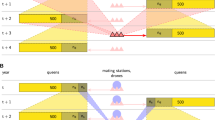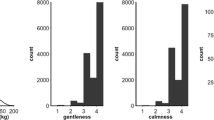Summary
Hierarchies in worker dominance are well developed in reproductive workers of the Cape honeybee (Apis mellifera capensis Esch.). Elements that influence worker dominance (trophallactic behaviour, fecundity, “queen substance” content) are mainly genetically determined. The estimated values for the heritabilities in the broader sense range from 0.27 to 0.89. This genetically based hierarchy leads to new insight into the theory of natural selection in honeybees. Besides selection at the colony level, or selection at the level of reproductives, natural selection also operates at the level of the individual worker bee within a colony.
Similar content being viewed by others
References
Butler CG, Fairey EM (1963) The role of the queen in preventing oogenesis in worker honeybees. J Apic Res 2:14–18
Crewe RM, Velthuis HHW (1980) False queens: a consequence of mandibular gland signals in worker honeybees. Natur-wissenschaften 67:467
Franks NR, Scovell E (1983) Dominance and reproductive success among slave-making worker ants. Nature 304:724–725
Hemmling C,Koeniger N, Ruttner F (1979) Quantitative Bestimmung der 9-Oxodecensäure im Lebenszyklus der Kapbiene (Apis mellifera capensis Escholtz). Apidologie 10:227–240
Korst PJAM, Velthuis HHW (1982) The nature of trophallaxis. Insectes Soc 29:209–221
Moritz RFA (in press) Two parthenogenetical strategies of laying workers in honeybee populations (Apis mellifera L.). Entomol Gen
Röseler P-F, Röseler I (1977) Dominance in bumblebees. Proc 8th Int Congr IUSSI, Wageningen, pp 232–235
Ruttner F, Hesse B (1981) Rassenspezifische Unterschiede in der Ovarentwicklung und Eiablage von weisellosen Arbeiterinnen. Apidologie 12:159–183
Saiovici M (1983) Oxodecenoic acid and dominance in honey bees. J Apic Res 22:27–32
Spiess EB (1977) Genes in populations. Wiley, New York
Starr CK (1979) Origin and evolution of insect sociality: A review of modern theory. In: Hermann HR (ed) Social insects, vol 1. Academic Press, New York, pp 38–61
Verma S, Ruttner F (1983) Cytological analysis of the thelytokous parthenogenesis in the cape honeybee (Apis mellifera capensis Escholtz). Apidologie 14:41–57
Wilson EO (1975) Sociobiology. Harvard University Press, Cambridge, Mass
Author information
Authors and Affiliations
Rights and permissions
About this article
Cite this article
Moritz, R.F.A., Hillesheim, E. Inheritance of dominance in honeybees (Apis mellifera capensis Esch.). Behav Ecol Sociobiol 17, 87–89 (1985). https://doi.org/10.1007/BF00299434
Received:
Accepted:
Issue Date:
DOI: https://doi.org/10.1007/BF00299434




